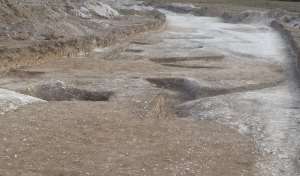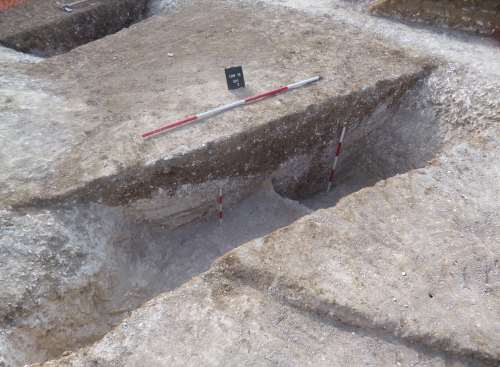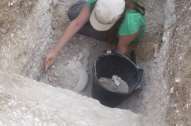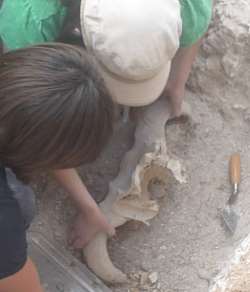This is our first day back on site after the weekend, a chance to catch up with where we got to and plan for the next few days.
We are beginning to get to grips with the southern part of the site, where the ring ditch is cut away by a later group of pits, or perhaps by a large single pit.

In places we have had to start emptying a section excavated in 1982, to make sense of the hand written records we have of the excavation carried out in the area in 1982. In doing so we have encountered several artefacts contemporary with that dig, including wrappers for a twix and a six pack bag of hula hoops, both apparently of 1982 vintage. Other material includes a rather stubborn sheet of polythene covering what seems to be an old kitchen door! All this material apparently put in the section to ‘protect’ the archaeology.
Checking the old records it appears that sections were excavated through the ring ditch on a system of compass bearings rather than by considering the orientation of the features, so the sections were undoubtedly not representative of the true relationships between the features, nor very useful in defining the dimensions of the later features, which it seems include a substantial central cut feature. More work is to be done here in the next few days to completely understand the later features.

Digging on the second segment through the ring ditch was completed today and the area was cleaned for photography, ready for recording the plan and sections tomorrow. So far we have established that the wide and straight sided cut of the ring ditch lies on the eastern side of the segment. Once again, we have been impressed by the sheer scale of the ditches that were cut into the hard chalk of the hill top. The care and precision taken to make the ring ditch on this site, demonstrated in the uniform profile and the regular circuit, shows that was almost sculpted out of the chalk geology. In common with many other examples in Thanet, this ditch shows no sign of deviating from its plan where variations were encountered in bedding planes of the chalk . These substantial archaeological features are as ‘architectural’ in their design and careful construction as any standing structure.
On the eastern side of the segment is another pit, cutting through what would have been the interior of the ring ditch. The lower fill was mainly composed of layers of chalk silt alternating with thin bands of chalky soil. No datable finds were found in these layers of chalky fill. More work needs to be done to confirm the shape of this feature in plan, and to prove our suspicion that it is later than the ring ditch, which we can’t prove conclusively from the section we have exposed. Before we do any further work both sections will need to be drawn, a job for tomorrow…

In the first segment, we continued to reduce the chalky fills at the base of the ditch. The star find of the day was part of a large cattle skull, lying at the base of a chalky fill deposit, over one of the lower less chalky fills near the base of the feature. Probably an example of a type of wild cattle known as Aurochs (Bos primigenius), which was distributed widely over Europe may also have been domesticated by the time the ring ditch was made. The skull appears to have been tipped in with the fill and its location does not seem particularly significant to the interpretation of the ring ditch.
However it is an interesting find and casts light on the type of animal that occupied the contemporary landscape with the ring ditch builders, and the sort of meat bearing or working animals that might have been used by the community that built the ring ditches that cover this landscape.

I’m impressed by the scale of these features, but also by how rapidly you have got to grips with them. The work all looks so neat and orderly: the site tidy and the sections all straight and therefore aiding the ability to comprehend what they show. This is a really good standard and example for those on the dig who are learning fieldwork practice. The cattle skull fragment is a wonderful find, it is so well preserved: I’m sure the specialists in ancient faunal remains will be able to tell you a lot about that animal. So much bright chalk: you must be wearing sunglasses. Do any snail shells survive in these fills?